
Transient events accompanying passivation of active surfaces in aluminum etch tunnels are investigated. Passivation is induced by pulsed reductions of the anodic etching current, of several milliseconds duration. Scanning electron microscopy is used to measure the area passivated. Potential transients are analyzed to identify a possible potential driving force for passivation. For the experimental conditions of this work, at 0.13 ms after the current step, there is a temporary reduction in the metal dissolution current in tunnels. The change in dissolution current is proportional to the cathodic surface overpotential, relative to the critical repassivation potential. The transient reduction in dissolution current is associated with passivation, since no variation in dissolution current with potential is observed during steady tunnel growth. Surface changes resulting in permanent passivation occur later, at times between 3 and 12 ms after the current step.
Available at: http://works.bepress.com/kurtr_hebert/40/

This article is from Journal of the Electrochemical Society 138 (1991): 371–379, doi:10.1149/1.2085592. Posted with permission.